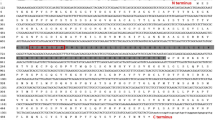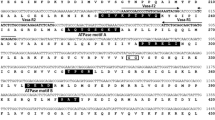Abstract
In order to gain a better understanding of the developmental processes of shrimp germ cells, the molecular cloning and characterization of a meiosis-related gene, Dmc1, was carried out using the whiteleg shrimp Litopenaeus vannamei. The cDNA of the L. vannamei Dmc1 homologue (LvDmc1) was 1,647 bp long and contained a 1,023-bp open reading frame corresponding to 341 amino acid residues. The deduced amino acid sequence contained motifs conserved in the RecA/Rad51 superfamily to which Dmc1 homologues belong and showed high identities with Dmc1 of other animals, including invertebrate and vertebrate species. RT-PCR revealed the presence of transcripts of LvDmc1 in gonads having meiotic germ cells. In situ hybridization analysis showed that LvDmc1 mRNA was abundantly expressed in premeiotic spermatogonia and oogonia, but not in gonadal somatic cells. LvDmc1 is thus a potentially useful indicator of the early stages of germ cell development.





Similar content being viewed by others
References
Bray WA, Lawrence AL (1992) Reproduction of Penaeus species in captivity. In: Fast AW et al (eds) Marine shrimp culture: principles and practices. Elsevier, Amsterdam, pp 93–170
Keller R (1992) Crustacean neuropeptides: structures, functions and comparative aspects. Experientia 48:439–448
Browdy CL (1992) A review of the reproductive biology of Penaeus species: perspectives on controlled shrimp maturation system for high quality nauplii production. In: Wyban J (ed) Proceeding of the special session on shrimp farming. World Aquaculture Society, Baton Rouge, pp 22–51
Cooke IM, Sullivan RE (1982) Hormones and neurosecretion. In: Atwood HL et al (eds) The biology of Crustacea, vol 3. Neurobiology: structure and function. Academic, New York, pp 206–278
Benzie JAH (1998) Penaeid genetics and biotechnology. Aquaculture 164:23–47
Ceballos-Vazquez BP, Rosas C, Racotta IS (2003) Sperm quality in relation to age and weight of white shrimp Litopenaeus vannamei. Aquaculture 228:141–151
Rosas C, Sanchez A, Chimal MAE, Saldana G, Ramos L, Soto LA (1993) The effect of electrical stimulation on spermatophore regeneration in white shrimp Penaeus setiferus. Aquat Living Resour 6:139–144
Ceballos-Vazquez BP, Aparicio-Simon B, Palacios E, Racotta IS (2004) Sperm quality over consecutive spermatophore regenerations in the Pacific white shrimp Litopenaeus vannamei. J World Aquacult Soc 35:178–188
Parnes S, Raviv S, Shechter A, Sagi A (2006) Males also have their time of the month! Cyclic disposal of old spermatophores, timed by the molt cycle, in a marine shrimp. J Exp Biol 209:4974–4983
Talbot P, Summers RG (1978) The structure of sperm from Panulirus, the spiny lobster, with special regard to the acrosome. J Ultrastruct Res 64:341–351
Kleve MG, Yudin AI, Clark WH Jr (1980) Fine structure of the unistellate sperm of the shrimp, Sicyonia ingentis (Natantia). Tissue Cell 12:29–45
Clark WH Jr, Kleve MG, Yudin AI (1981) An acrosome reaction in natantian sperm. J Exp Zool 218:279–291
Tsutsui N, Katayama H, Ohira T, Nagasawa H, Wilder MN, Aida K (2005) The effects of crustacean hyperglycemic hormone-family peptides on vitellogenin gene expression in the kuruma prawn, Marsupenaeus japonicus. Gen Comp Endocrinol 144:232–239
Ohira T, Okumura T, Suzuki M, Yajima Y, Tsutsui N, Wilder MN, Nagasawa H (2006) Production and characterization of recombinant vitellogenesis-inhibiting hormone from the American lobster Homarus americanus. Peptides 27:1251–1258
Tsutsui N, Ohira T, Kawazoe I, Takahashi A, Wilder MN (2007) Purification of sinus gland peptides having vitellogenesis-inhibiting activity from the whiteleg shrimp Litopenaeus vannamei. Mar Biotech 9:360–369
Rodríguez EM, López Greco LS, Medesani DA, Laufer H, Fingerman M (2002) Effect of methyl farnesoate, alone and in combination with other hormones, on ovarian growth of the red swamp crayfish, Procambarus clarkii, during vitellogenesis. Gen Comp Endocrinol 125:34–40
Mak AS, Choi CL, Tiu SH, Hui JH, He JG, Tobe SS, Chan SM (2005) Vitellogenesis in the red crab Charybdis feriatus: hepatopancreas-specific expression and farnesoic acid stimulation of vitellogenin gene expression. Mol Reprod Dev 70:288–300
Tiu SH, Hui JH, He JG, Tobe SS, Chan SM (2006) Characterization of vitellogenin in the shrimp Metapenaeus ensis: expression studies and hormonal regulation of MeVg1 transcription in vitro. Mol Reprod Dev 73:424–436
Bishop DK, Park D, Xu L, Kleckner N (1992) DMC1: a meiosis-specific yeast homolog of E. coli recA required for recombination, synaptonemal complex formation, and cell cycle progression. Cell 69:439–456
Shinohara A, Shinohara M (2004) Roles of RecA homologues Rad51 and Dmc1 during meiotic recombination. Cytogenet Genome Res 107:201–207
Kagawa W, Kurumizaka H (2010) From meiosis to postmeiotic events: uncovering the molecular roles of the meiosis-specific recombinase Dmc1. FEBS J 277:590–598
Habu T, Taki T, West A, Nishimune Y, Morita T (1996) The mouse and human homologs of DMC1, the yeast meiosis-specific homologous recombination gene, have a common unique form of exon-skipped transcript in meiosis. Nucleic Acids Res 24:470–477
Kajiura-Kobayashi H, Kobayashi T, Nagahama Y (2005) Cloning of cDNAs and the differential expression of A-type cyclins and Dmc1 during spermatogenesis in the Japanese eel, a teleost fish. Dev Dyn 232:1115–1123
Nagasawa K, Takeuchi Y, Miwa M, Higuchi K, Morita T, Mitsuboshi T, Miyaki K, Kadomura K, Yoshizaki G (2009) cDNA cloning and expression analysis of a vasa-like gene in Pacific bluefin tuna Thunnus orientalis. Fish Sci 75:71–79
Pittman DL, Cobb J, Schimenti KJ, Wilson LA, Cooper DM, Brignull E, Handel MA, Schimenti JC (1998) Meiotic prophase arrest with failure of chromosome synapsis in mice deficient for Dmc1, a germline-specific RecA homolog. Mol Cell 1:697–705
Leelatanawit R, Klinbunga S, Aoki T, Hirono I, Valyasevi R, Menasveta P (2008) Suppression subtractive hybridization (SSH) for isolation and characterization of genes related to testicular development in the giant tiger shrimp Penaeus monodon. BMB Rep 41:796–802
Thompson JD, Higgins DG, Gibson TJ (1994) CLUSTALW. Nucleic Acids Res 22:4673–4680
Saitou N, Nei M (1987) The neighbor-joining method: a new method for reconstructing phylogenetic trees. Mol Biol Evol 4:406–425
Hasson KW, Hasson J, Aubert H, Redman RM, Lightner DV (1997) A new RNA-friendly fixative for the preservation of penaeid shrimp samples for virological detection using cDNA genomic probes. J Virol Methods 66:227–236
Story RM, Steitz TA (1992) Structure of the recA protein-ADP complex. Nature 355:375–376
Chen LT, Ko TP, Chang YC, Lin KA, Chang CS, Wang AHJ, Wang TF (2007) Crystal structure of the left-handed archaeal RadA helical filament: identification of a functional motif for controlling quaternary structures and enzymatic functions of RecA family proteins. Nucleic Acids Res 35:1787–1801
Hong EL, Shinohara A, Bishop D (2001) Saccharomyces cerevisiae Dmc1 protein promotes renaturation of single-strand DNA (ssDNA) and assimilation of ssDNA into homologous super-coiled duplex DNA. J Biol Chem 276:41906–41912
Aihara H, Ito Y, Kurumizaka H, Yokoyama S, Shibata T (1999) The N-terminal domain of the human Rad51 protein binds DNA: structure and a DNA binding surface as revealed by NMR. J Mol Biol 290:495–504
Kinebuchi T, Kagawa W, Kurumizaka H, Yokoyama S (2005) Role of the N-terminal domain of the human DMC1 protein in octamer formation and DNA binding. J Biol Chem 280:28382–28387
Yoshida K, Kondoh G, Matsuda Y, Habu T, Nishimune Y, Morita T (1998) The mouse RecA-like gene Dmc1 is required for homologous chromosome synapsis during meiosis. Mol Cell 1:707–718
Zhang P, Lv L, Xing W (2010) Early meiotic-specific protein expression in post-natal rat ovaries. Reprod Domest Anim (in press)
Acknowledgments
This work was supported by the Research and Development Program for New Bio-industry Initiatives of the Bio-oriented Technology Research Advancement Institution (BRAIN) of Japan. We are grateful to Y. Furusawa and H. Endo of the Japan International Research Center for Agricultural Sciences for technical assistance and rearing of the experimental animals.
Author information
Authors and Affiliations
Corresponding author
Rights and permissions
About this article
Cite this article
Okutsu, T., Kang, B.J., Miwa, M. et al. Molecular cloning and characterization of Dmc1, a gene involved in gametogenesis, from the whiteleg shrimp Litopenaeus vannamei . Fish Sci 76, 961–969 (2010). https://doi.org/10.1007/s12562-010-0295-6
Received:
Accepted:
Published:
Issue Date:
DOI: https://doi.org/10.1007/s12562-010-0295-6




